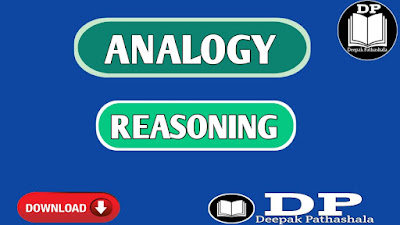ANALOGY
Analogy questions test the ability to recognize relationships between words or ideas and to know when these relationships are parallel.
The analogy sub-test is an area where, with practice, you can achieve a very good Score. First, you must find the relationship between the original pair of words. To help you, listed below are some common types of analogies. The list contains some Overlapping and similarities, and the precise names of the categories need not be memorized. It is important, however, that you learn types of relationships to look for.
Some Common Types of Analogies
PART and WHOLE: sole:shoe
WHOLE and PART: hand:fingers
CLASS and MEMBER: fish:salmon
TYPE OF: debate:argument
DEGREE: cool:frigid
OPPOSITES: tall:short
WORKER and TOOL: photographer.camera
WORKER and WORKPLACE: teacher:classroom
CAUSE and EFFECT (RESULT): poison:death
EFFECT and CAUSE: death:poison
ACTION and THAT WHICH PERFORMS IT fly:plane
PURPOSE (or OBJECT:ACTION): scissors:cut
INDICATION OF: boo:disapproval
SYNONYMS: canine:dog
STUDY OF: linguistics:language
CHARACTERISTIC OF: dexterity:pianist
DEFINITION: hero:courage (by definition, a hero has courage)
LACK OF DEFINITION: coward:courage (by definition, a coward lacks courage)
Tips For The Analogy Section:
The Reasonable and Inevitable or Valid and Necessary Connection Rule You should keep in mind that there must be a reasonable and necessary connection between two words.
The connection must be VALID, otherwise there would be no point in making the analogy. For example, what reasonable connection could there be between bird:algebra? On the other hand, there is a reasonable connection between fish:salmon since salmon is a type of fish. The connection must also be NECESSARY or INEVITABLE.
There is a necessary connection between photographer.photo since a photographer by definition takes photos. However, the connection between student:photo is only a possible one since a student may or may not take photos. Any choices that fail to meet these criteria should be rejected. If you cannot figure out the connection between the original pair, you can still improve your chances of original picking the correct answer by eliminating any choices that do not confirm to the above rule.
Make Up a Sentence
Creating a sentence that shows the connection between the two words is absolutely essential and is the difference between a high or low mark on analogies
For example, if the first pair of words is APPLAUSE:APPROVAL, your sentence might be:
"Applause is an indication of approval (an indicate of analogy)." If the first pair is chisel: sculptor, you might say "A chisel is a tool used by a sculptor to perform his work (a tool:worker analogy)"
Be as Precise as Possible
It is important to make your bridge sentence as precise as possible. In the example below, note how a very general sentence can narrow your choices only slightly while a more precise one can lead you to the correct answer.
Example
MINISTER : SERMON
(A) politician:promises (B) heckler:interruptions (C) doctor:diagnosis
(D) lecturer:speech (E) curator:museum
For example, we could say:
A minister makes/gives sermons
A politician makes promises
A heckler makes interruptions.
A doctor makes a diagnosis
A lecturer makes a speech.
A curator makes a museum. (eliminate).
These sentences only eliminate (E) and aren't a lot of help. But, if we say: "One of the functions of a minister is to teach through sermons" then we eliminate all choices but (D), that is, "One of the functions of a lecturer is to teach through speeches."
The Parts of Speech Must Match
If the capitalized pair are NOUN:NOUN, then the correct answer must also be noun:noun. If the capitalized pair are NOUN:ADJECTIVE, then the correct answer must be noun: adjective, etc. Most analogies involve nouns or adjectives. You will find this "part of speech" rule most helpful when a word is used in a way that may be unfamiliar to you. Try this one:
Example
RIFLE:RANSACK.:
(A) search:destroy (B) shoot: kill (C) speak:orate
(E) elucidate.clarify (D) pontificate:discuss
Since all the choices here are verbs, rifle must also be used as a verb. (B) is probably misleading, then, since it's based on a gun. If you didn't know what the word rifle meant when it is used as a verb, then consider what possible type of analogy we have here. (C) and (D) are roughly synonymous while (E) is a true synonym. Possibly a synonym is needed, so you guess (E). And you're right: rifle does mean to ransack.
Be Alert to Multiple Meanings
Even though the part of speech remains the same (unlike our rifle example), a word may have multiple meanings. If you are having difficulty figuring out the analogy, perhaps you are using the wrong definition for one of the words.
The Answer Must Be in the Same Order
Make sure that the capitalized words and the pair you choose are in the same order. COLLAGE:ARTIST novel: author composer:sonata
A collage is a work of art created by an artist.
A novel is a work of literary art created by a novelist.
A composer is NOT a work of musical art created by a sonata.
(The reverse is true: a sonata is a work of musical art created by a composer.)
Note PDF View
Download PDF Link
More Links
Disclaimer
The content of Computer, Commerce, Reasoning, provided for the educational purpose. This is the study materials for the Commerce & other students. These books, Notes PDF, Article are authorized by own publications, we provide Article/PDF for educational purpose. Any copyright climb please mail to the ‘DeepakPathasala’ official email response as soon as possible.


